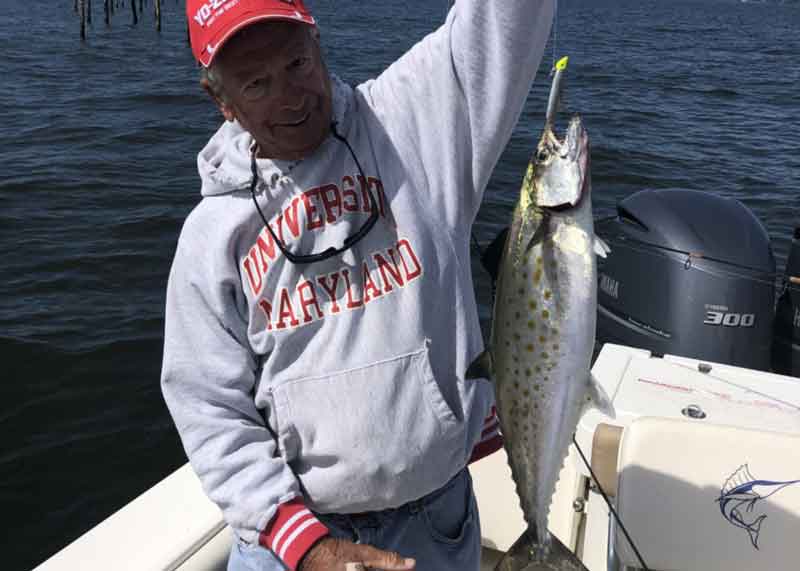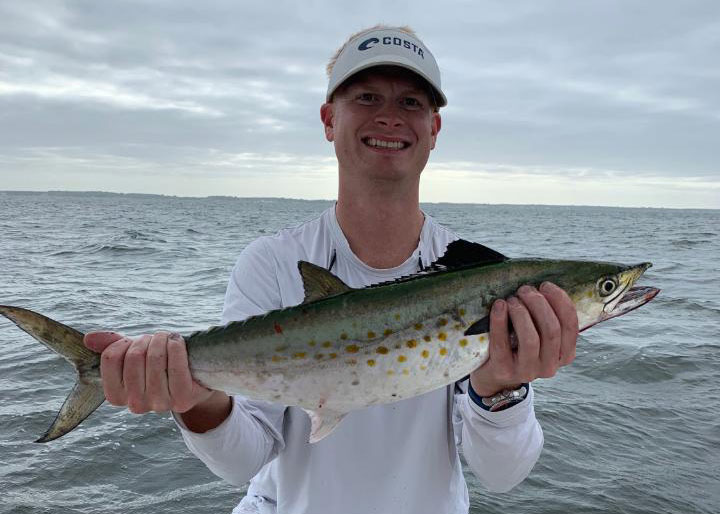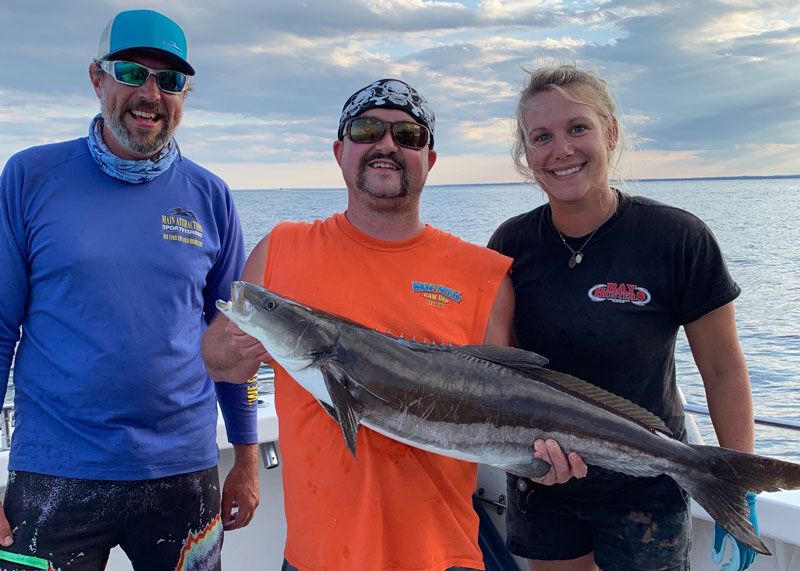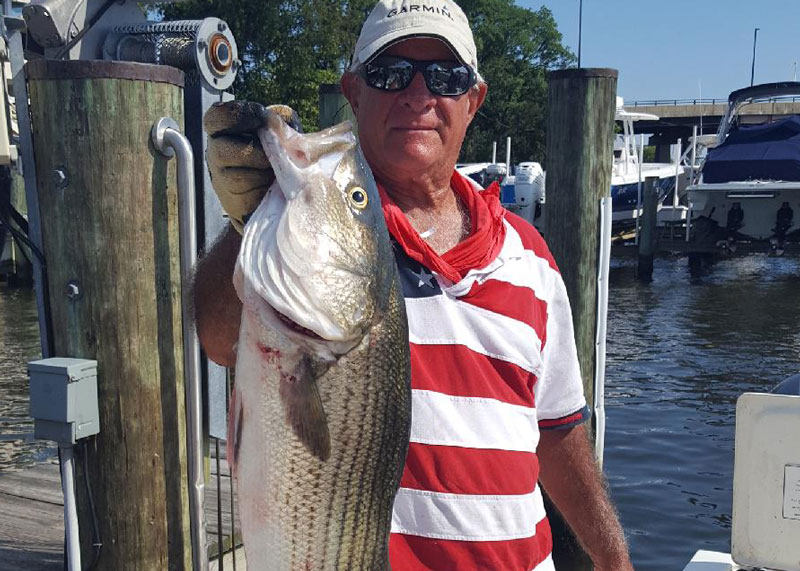Middle Chesapeake Bay Fishing Report, September 27, 2019 Update:
Spanish mackerel remain the star of the show in the Middle Bay and show no signs of heading south or slowing down as of yet. If anything mackerel fishing has picked up, and Angler’s reported that the area from the 83 and 84 to Bloody Point and the mouth of the Choptank have been great for trollers, who are primarily pulling small Clark spoons and small Drones. We also had a reader report of a 27-inch Spanish Mackerel caught on a chartreuse tube trolling between five and six knots. Typically, anglers targeting mackerel have been cruising around eight knots. Anglers who aren’t catching mackerel via trolling have typically been keeping their eyes on the horizon, and heading to working birds when they're spotted. Mackerel can be tempted with metal lures run through the action quickly, and plenty of bluefish have been landed as well.

Spanish have also been continuing to chew at Thomas Point, which happens to be a focal point for rockfish. But the pressure is heavy, and getting out early and beating the fleet has been essential. Most anglers targeting the rock have been live-lining with spot or small white perch, which can easily be located in the tribs. Both species are glad to take bloodworms on bottom rigs. In the rivers, meanwhile, Alltackle reported that fall schoolies are beginning to gather and will take topwater plugs at sunset.
Further south near Cove Point red drum are under the breaking stripers, blues, and mackerel as well. If you want to target the drum, jigging soft plastics or two-ounce jigging spoons down deep under the bait is the ticket. Angler in Chief Lenny Rudow fished out of Solomons this week with FishTalk contributor Captain Walleye Pete, and said the ticket to success was hitting schools of breaking fish very briefly and unless big marks were spotted on the meter, being quick to leave one school and look for another. There are a ton of pods of micro-rock between 10 and 14 inches around from Cedar Point down, and if you spend too much time messing with them you might not locate the better batches of fish – which can hold drum, Spanish (of very large size), blues (up to three pounds) and stripers (up into the low 20s).
Crabbing Report: Middle Bay tribs and Eastern Bay all offer decent crabbing right now. Four to eight feet is the zone, shallower or deeper being best depending on the tide.
Middle Chesapeake Bay Fishing Report, September 19, 2019 Update:
Anglers on the Middle Bay have been grateful that the Spanish are sticking around to provide them with continued mind-blowing mackerel action. The channel edges and the area around Buoys 83 to 84 have been buzzing with boats pulling small Clarks spoons and small Drones hoping to land a mackerel or 20. One difference noted from last week to this week – the most effective speed does seem to have dropped a bit, with seven or eight mph proving most effective according to some reports more recently. Many boats are locating them easily, and enjoying a quick morning on the water. Angler in Chief Lenny Rudow reports a truly epic Spanish mackerel bite in the vicinity of Thomas Point, and said that at one point last weekend there were so many mackerel jumping 360-degrees around the boat that everyone pretty much just stood there and stared in awe for a couple moments, with their lures hanging from the rod tips. HHCB popping cork rigs and spoons both proved effective for casting to the mackerel, with pink a stand-out color. Many were huge for the species, and he said he thinks he hooked, fought, and then lost – right at the boat – the biggest Spanish he’s ever tied into. Oh, yeah – and there were also stripers galore (mostly small but plenty of keepers up to 22 inches) plus some bluefish mixed in.

Anglers searching for stripers in specific have primarily been gathered around Thomas Point, where Alltackle in Annapolis reported that most boats are livelining. Although the bite is good, much of the catch has been undersized. The same can be said about fish caught under birds near Thomas and also Tolly Point; although the catch is abundant not many keepers are being produced from many of the schools. The birds, however, are producing a variety of species, and many anglers opting to throw a metal spoon through the bait and reel fast have been rewarded with Spanish mackerel. The trick seems to be to abandon schools of diaper-stripers quickly after reeling up one or two fish, unless you hook a bigger one or visually confirm the presence of mackerel.
Monster redfish remain in play, in the Choptank-to-Patuxent-to-Calvert Cliffs zone. It’s by no means a sure bet, but if you spot working birds, dropping jigging spoons and large (10-inch) plastics deep below the frenzy has been the ticket. Several readers who did get lucky finding them sent in pics this week of multiple catches including up to seven(!) ginormous reds in one day of fishing.
In the Patuxent, The Tackle Box let us know that fishing for speckled trout has been stellar. Plenty of the fish have been keepers, and they are mostly hanging on bottom around oyster beds. Most anglers have been opting to troll small bucktails. And mixed in with the specks are plenty of rockfish.
Throughout the tribs, white perch are still active and biting. They’ve easily been located by anglers dropping bloodworms on a bottom rig near shore, or by casting Perch Pounders to the shoreline.
Middle Chesapeake Bay Fishing Report, September 13, 2019 Update:
With several other areas of Bay experiencing a drop in the quantity and quality of fish being caught, the Middle Bay is getting attention from anglers up and down the Bay’s shorelines. Make sure to get out early, in part to secure a sound position to fish, but also because the bite has been best just after the sun breaks the horizon. Much of the action has been centered around Thomas Point, where Alltackle reports that the live-lining bite is still hot. Luckily, spot haven’t retreated from the tributaries and can easily be located on a hard bottom, in eight to 10 feet of water. They’re eager to take bloodworm on a bottom rig. Make sure that when you’re stocking up you catch enough to last the day - a hot schoolie bite can easily run through your supply, which is a real bummer if you’re planning to stay on the water until you fill the fishbox.

Those searching for spot at Tolly Point have also encountered plenty of nice perch and some spot as big or bigger than them. If you run out of bait-sized spot (or just prefer jigging), a six-inch BKD bounced off bottom is also putting the bend in many anglers’ rods. However, anglers looking to diversify their catch have more often been trolling the channel edges, where stripers and Spanish mackerel are abundant. We had three picture-verified monster macks breaking the 30-inch mark come from the area this week. Angler’s reported that most boats are sticking to the traditional small Clark spoons, Drones, and pink or yellow Hard Head Custom Baits pulled behind number-one planers. Spanish mackerel are more likely to hit these if they’re trolled fast, at over eight mph. Throwing bucktails in the mix increases the likelihood of landing stripers, but trolling this fast also reduces the number of stripers. If you’re ultra-determined to have a multi-species day (or just want fast action), Island Tackle Outfitters suggested keeping a pair of eyes on the horizon. Decent fish are holding under working birds, which have been a common sight. Tossing a metal lure or spoon into the mix and then reeling fast is a great way to tempt the Spanish mackerel.
While fishing from Sharp’s Island flats down to Point No Point this week a reader reported (photo verified) encountering birds which not only held breaking bluefish and rockfish underneath but also multiple red drum between 46 and 48 inches on a jig, and two other readers reported single drum in this size range caught in the area. Catching large red drum under breaking fish hasn’t been uncommon recently - Angler’s verified that guys jigging spoons or soft plastics under them are often hooking up some big ones. The best way to locate them in this section of the Bay has been searching for the birds.
In the tribs white perch are still biting, and are happy to take bloodworm on a bottom rig. They’ve been most active during dawn and dusk, although this week had them starting up a little earlier. For the most part, anglers have been catching them around piers, docks, and other shaded structures.
Crabbing report: quick, get some chicken necks! Full bushel baskets are happening! Six feet is good depth to hit right now.
Middle Chesapeake Bay Fishing Report, September 6, 2019 Update:
As we move into September, the inevitable end to warm days on the water has been made somewhat less bitter by the satisfaction many anglers are receiving from the wonderful Spanish mackerel bite that continues to please anglers in the Middle Chesapeake this year. Although the summer is wrapping up, it’s impossible to look back on it with anything but gratefulness and wonder. The spot were plentiful, striped bass abundant, Spanish mackerel further north and running stronger than in recent decades. With that being said, we’ve still got a few more weeks of nice weather to be on the water chasing those macks and Anglers Sport Center let us know that the bite has remained very active stretching from the channel edges just north of the Bay Bridge, all the way South. Anglers pulling small Clark spoons, small Drones, and pink or yellow Hard Head Custom Baits along the channel edges are experiencing great success while trolling between eight and 10 knots.

If you’re going after the mackerel be sure to keep a pair of binoculars on the horizon as you troll along. Aside from trolling, the best way to land the fish has been locating diving birds and casting into the bait underneath them. A metal lure or spoon tossed into the mix and reeled quickly has often ended up with a Spanish mack on the hook. The diving birds and bait balls are also holding stripers, although oftentimes they’ve been small. They’re more apt to take soft plastics, reeled in a bit more slowly. And we received a couple more reader reports this week of anglers who got particularly lucky and hooked up with big red drum in the 40-plus-inch class, jigged up on spoons and plastics from beneath the fray from the Choptank, south.
Stripers also can be found around Thomas Point, the Bay Bridge Pilings, and the lower Choptank. Alltackle in Annapolis suggested livelining in these locations as most boats have been showing up stocked with spot. Heading to areas with a hard bottom and eight to ten feet of water gives you a pretty solid chance to catch your bait before heading out. Some others are casting into working birds and finding fish up to 22-inches, though there are far more throwbacks than keepers busting the water.
Angler in Chief Lenny Rudow reports that multiple evening trips to Thomas Point, the ships, and nearby areas has resulted in tons of jigging action, though most of the fish are in the 14- to 20-inch range and even 22-inchers have been tough to come by. When you spot birds only take a cast or two and if it’s micro-fish, diaper-stripers, and Alabama stripers (as in, Little Rock) it’s best to stop harassing the babies and just move on. Fortunately, in the tributaries white perch and catfish remain active. During early morning and afternoon hours, they can be located near structure and in shaded areas. White perch are happy to take bloodworms or grass shrimp on a bottom rig, while catfish will take cut menhaden or chicken breast.